MAZDA MODEL CX-7 2007 (in English) Owner's Manual
Manufacturer: MAZDA, Model Year: 2007, Model line: MODEL CX-7, Model: MAZDA MODEL CX-7 2007Pages: 406, PDF Size: 6.11 MB
Page 21 of 406

Black plate (21,1)
NOTE
The seat temperature is regulated
automatically by a thermostat. Other
than turning it on or off, it cannot be
adjusted.
Rear Seat
WARNING
Do not stack cargo higher than the
seatbacks:
Stacking luggage or other cargo
higher than the seatbacks, and placing
articles on the rear seat is dangerous.
During sudden braking or a collision,
objects can fly around and become
projectiles that may hit and injure
passengers.
Make sure luggage and cargo is
secured before driving:
Not securing cargo while driving is
dangerous as it could move or be
crushed during sudden braking or a
collision and cause injury.
Make sure the adjustable components
of a seat are locked in place:
Adjustable seats that are not securely
locked are dangerous. In a sudden
stop or collision, the seat or seatback
could move, causing injury. Make sure
the adjustable components of the seat
are locked in place.
Essential Safety Equipment
Seats
2-9
CX-7_8V28-EA-06B_Edition2 Page21
Monday, March 13 2006 5:5 PM
Form No.8V28-EA-06B
Page 22 of 406

Black plate (22,1)
WARNING
Do not drive with the seatback
unlocked:
The seatback plays an important role
in your protection in a vehicle.
Leaving the seatback unlocked is
dangerous as it can allow passengers
to be ejected or thrown around and
baggage to strike occupants in a
sudden stop or collision, resulting in
severe injury. After returning the
seatback at any time, even when there
are no other passengers, rock the
seatback to make sure it is locked in
place.
Never allow a passenger to sit or stand
on the folded seatback while the
vehicle is moving:
Driving with a passenger on the folded
seatback is dangerous. Allowing a
child to sit up on the folded seatback
while the vehicle is moving is
particularly dangerous. In a sudden
stop or even a minor collision, a child
not in a proper seat or child-restraint
system and seat belt could be thrown
forward, back or even out of the
vehicle resulting in serious injuries or
death. The child in the baggage area
could be thrown into other occupants
and cause serious injury.
NOTE
When returning a rear seat to its
original position, also replace the seat
belt to its normal position. Verify that
the seat belt pulls out and retracts.
qSplit-Folding Rear Seatback
The seatbacks can be folded down to
provide more space in the luggage
compartment.
To fold the seatbacks
WARNING
Always remove the child-restraint
system from the rear seat before
operating the remote handle levers for
the rear seat:
Operating the remote handle levers
while a rear-facing child-restraint
system is in the rear seat is dangerous.
It could cause injury to a child seated
in the child-restraint system when the
seatback suddenly flips forward.
Make sure there is nobody in the rear
seat area before operating the remote
handle levers:
Not checking the rear seat area for
persons before folding the seatbacks
with the remote handle levers is
dangerous. The rear seat area is
difficult to see from the rear of the
vehicle. Operating the remote handle
levers without checking could cause
injury to a person when a seatback
suddenly flips forward.
CAUTION
Before folding the seatbacks with the
remote handle levers, make sure there is
no cup in a rear cup holder. Folding the
seatbacks with the remote handle levers
while a cup is in the cup holder could
soil or damage the seat bottom and
seatback.
2-10
Essential Safety Equipment
Seats
CX-7_8V28-EA-06B_Edition2 Page22
Monday, March 13 2006 5:5 PM
Form No.8V28-EA-06B
Page 23 of 406

Black plate (23,1)
When using the remote handle levers:
CAUTION
Be careful of the following when using
the remote handle levers:
lOn a downward slope, the seatback
could flip forward faster than on a
flat area.
lOn an upward slope, the seatback
may not fold down. When the
seatbacks cannot be folded down
with levers, pull the rear seatback
forward from inside the vehicle.
1. Unfasten the lap portion of the center-
rear seat belt (page 2-21).
CAUTION
Always unfasten the lap portion of the
belt before folding left-rear seatback.
Leaving the lap portion of the belt
fastened could cause damage to the seat
belt, buckle and seatback.2. After checking that the rear seats are
clear, open the liftgate compartment
and pull the remote handle levers on
the left and right side of the liftgate
compartment.
When using the rear seatback knobs:
CAUTION
When operating the rear seatback knob,
make sure you support the seatback
with your hand. If the seatback is not
supported with your hand, it will flip
forward suddenly and could cause
injury to the finger that pushes the rear
seatback knob down.
1. Unfasten the lap portion of the center-
rear seat belt (page 2-21).
CAUTION
Always unfasten the lap portion of the
belt before folding the rear-left
seatback. Leaving the lap portion of the
belt fastened could cause damage to the
seat belt, buckle and seatback.
2. Support the seatback with your hand.
Essential Safety Equipment
Seats
2-11
CX-7_8V28-EA-06B_Edition2 Page23
Monday, March 13 2006 5:5 PM
Form No.8V28-EA-06B
Page 24 of 406
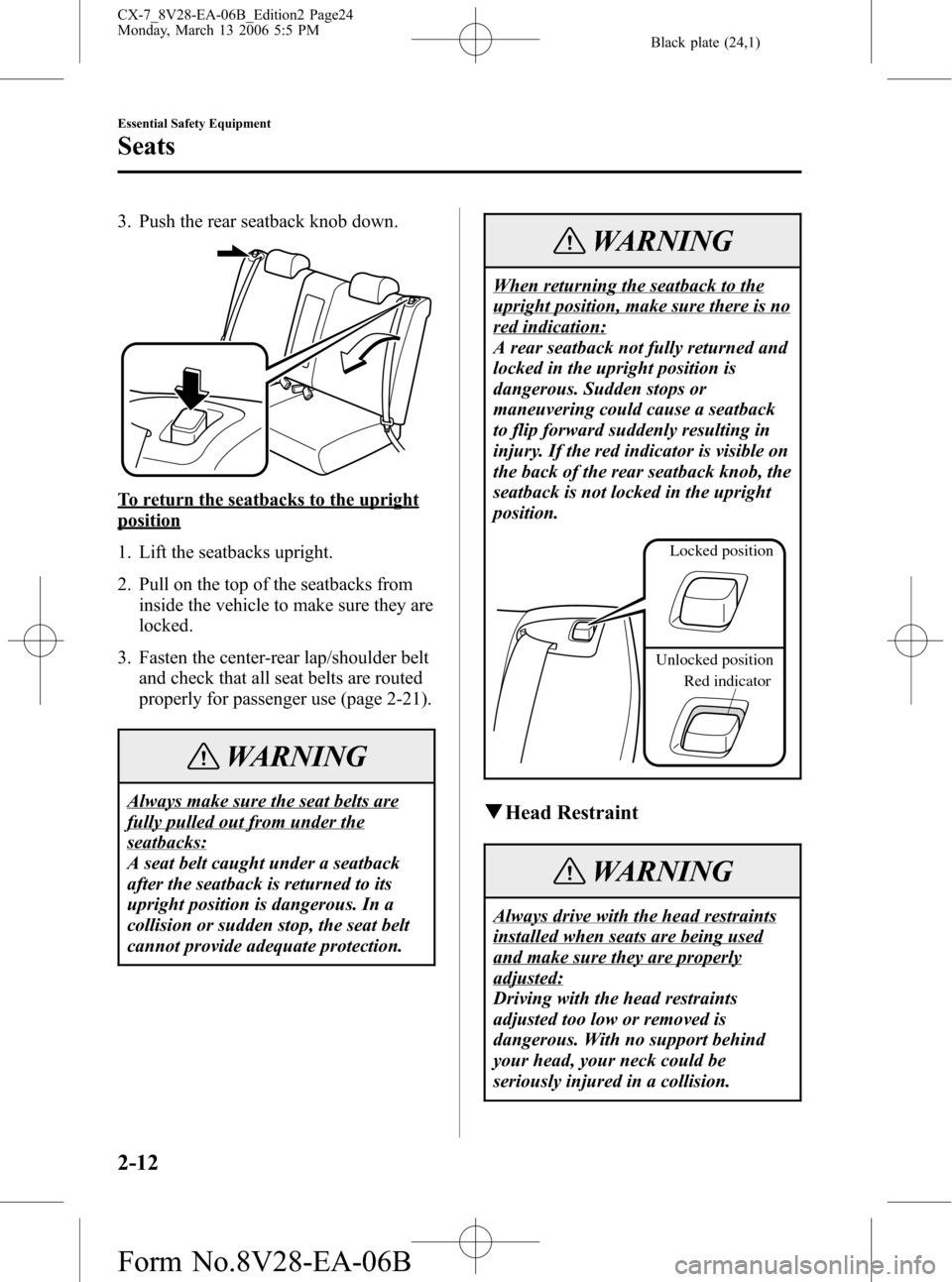
Black plate (24,1)
3. Push the rear seatback knob down.
To return the seatbacks to the upright
position
1. Lift the seatbacks upright.
2. Pull on the top of the seatbacks from
inside the vehicle to make sure they are
locked.
3. Fasten the center-rear lap/shoulder belt
and check that all seat belts are routed
properly for passenger use (page 2-21).
WARNING
Always make sure the seat belts are
fully pulled out from under the
seatbacks:
A seat belt caught under a seatback
after the seatback is returned to its
upright position is dangerous. In a
collision or sudden stop, the seat belt
cannot provide adequate protection.
WARNING
When returning the seatback to the
upright position, make sure there is no
red indication:
A rear seatback not fully returned and
locked in the upright position is
dangerous. Sudden stops or
maneuvering could cause a seatback
to flip forward suddenly resulting in
injury. If the red indicator is visible on
the back of the rear seatback knob, the
seatback is not locked in the upright
position.
Locked position
Unlocked position
Red indicator
qHead Restraint
WARNING
Always drive with the head restraints
installed when seats are being used
and make sure they are properly
adjusted:
Driving with the head restraints
adjusted too low or removed is
dangerous. With no support behind
your head, your neck could be
seriously injured in a collision.
2-12
Essential Safety Equipment
Seats
CX-7_8V28-EA-06B_Edition2 Page24
Monday, March 13 2006 5:5 PM
Form No.8V28-EA-06B
Page 25 of 406
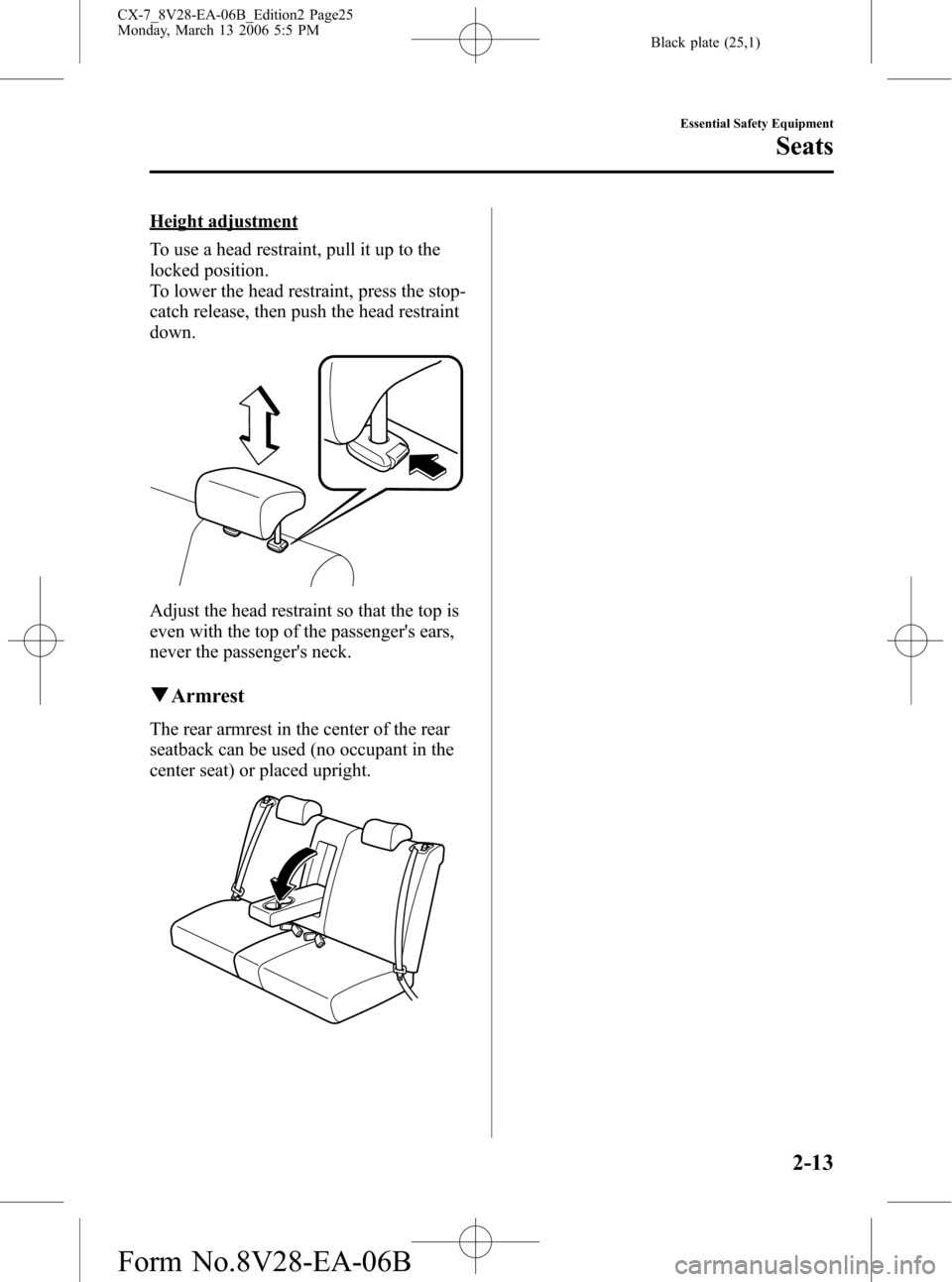
Black plate (25,1)
Height adjustment
To use a head restraint, pull it up to the
locked position.
To lower the head restraint, press the stop-
catch release, then push the head restraint
down.
Adjust the head restraint so that the top is
even with the top of the passenger's ears,
never the passenger's neck.
qArmrest
The rear armrest in the center of the rear
seatback can be used (no occupant in the
center seat) or placed upright.
Essential Safety Equipment
Seats
2-13
CX-7_8V28-EA-06B_Edition2 Page25
Monday, March 13 2006 5:5 PM
Form No.8V28-EA-06B
Page 26 of 406
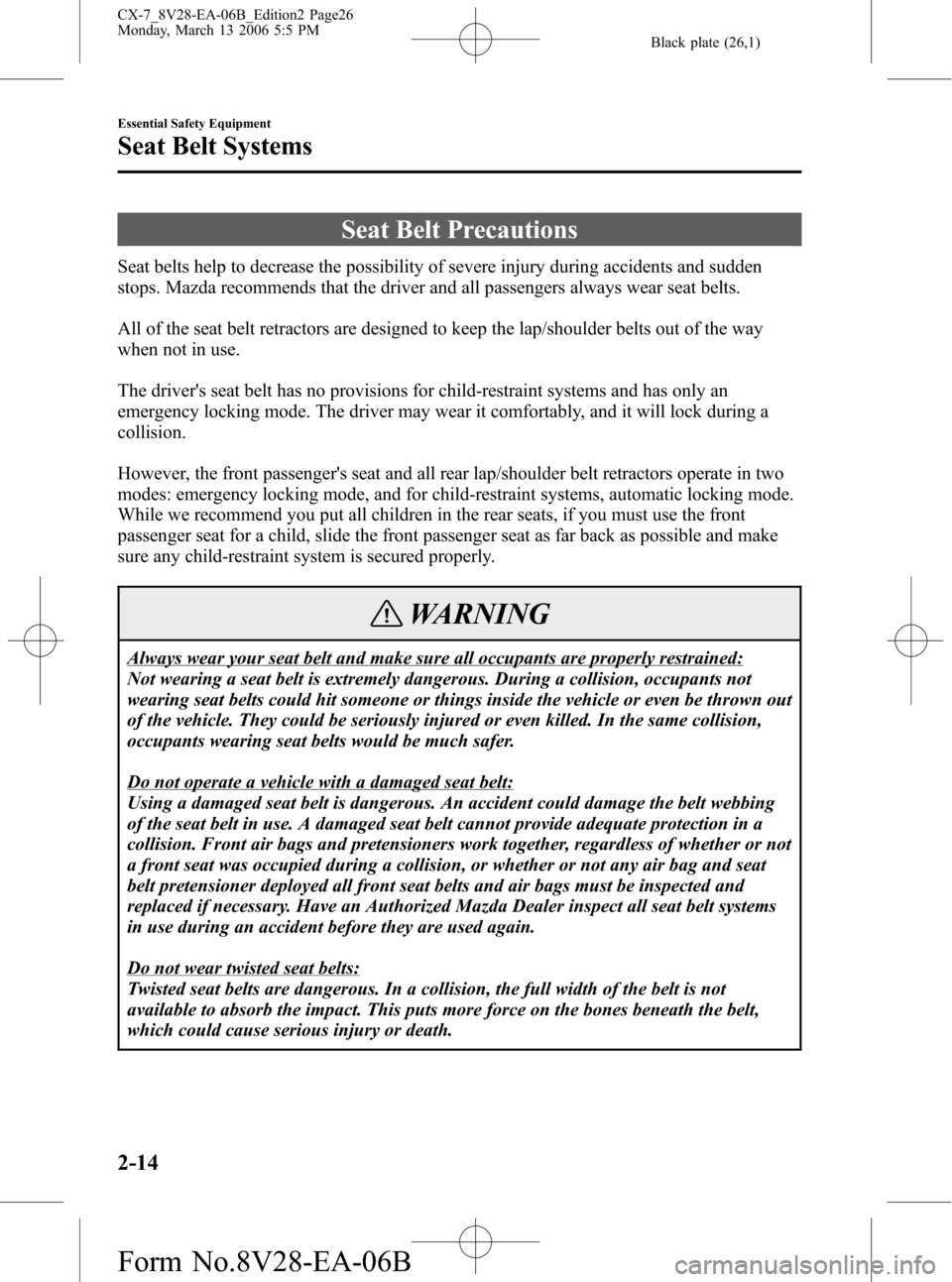
Black plate (26,1)
Seat Belt Precautions
Seat belts help to decrease the possibility of severe injury during accidents and sudden
stops. Mazda recommends that the driver and all passengers always wear seat belts.
All of the seat belt retractors are designed to keep the lap/shoulder belts out of the way
when not in use.
The driver's seat belt has no provisions for child-restraint systems and has only an
emergency locking mode. The driver may wear it comfortably, and it will lock during a
collision.
However, the front passenger's seat and all rear lap/shoulder belt retractors operate in two
modes: emergency locking mode, and for child-restraint systems, automatic locking mode.
While we recommend you put all children in the rear seats, if you must use the front
passenger seat for a child, slide the front passenger seat as far back as possible and make
sure any child-restraint system is secured properly.
WARNING
Always wear your seat belt and make sure all occupants are properly restrained:
Not wearing a seat belt is extremely dangerous. During a collision, occupants not
wearing seat belts could hit someone or things inside the vehicle or even be thrown out
of the vehicle. They could be seriously injured or even killed. In the same collision,
occupants wearing seat belts would be much safer.
Do not operate a vehicle with a damaged seat belt:
Using a damaged seat belt is dangerous. An accident could damage the belt webbing
of the seat belt in use. A damaged seat belt cannot provide adequate protection in a
collision. Front air bags and pretensioners work together, regardless of whether or not
a front seat was occupied during a collision, or whether or not any air bag and seat
belt pretensioner deployed all front seat belts and air bags must be inspected and
replaced if necessary. Have an Authorized Mazda Dealer inspect all seat belt systems
in use during an accident before they are used again.
Do not wear twisted seat belts:
Twisted seat belts are dangerous. In a collision, the full width of the belt is not
available to absorb the impact. This puts more force on the bones beneath the belt,
which could cause serious injury or death.
2-14
Essential Safety Equipment
Seat Belt Systems
CX-7_8V28-EA-06B_Edition2 Page26
Monday, March 13 2006 5:5 PM
Form No.8V28-EA-06B
Page 27 of 406

Black plate (27,1)
WARNING
Never use one seat belt on more than one person at a time:
Using one seat belt for more than one person at a time is dangerous. A seat belt used
in this way cannot spread the impact forces properly and the two passengers could be
crushed together and seriously injured or even killed. Never use one belt for more
than one person at a time and always operate the vehicle with each occupant properly
restrained.
In a rollover crash, an unbelted person is significantly more likely to die than a person
wearing a seat belt.
CAUTION
Belt retraction may become difficult if the belts and rings are soiled, so try to keep them
clean. For more details about cleaning the seat belts, refer to“Cleaning the Lap/Shoulder
Belt Webbing”(page 8-51).
qPregnant Women and Persons with Serious Medical Conditions
Pregnant women should always wear seat belts. Ask your doctor for specific
recommendations.
The lap belt should be worn SNUGLY AND AS LOW AS POSSIBLE OVER THE HIPS.
The shoulder belt should be worn across your shoulder properly, but never across the
stomach area.
Persons with serious medical conditions also should wear seat belts. Check with your
doctor for any special instructions regarding specific medical conditions.
Essential Safety Equipment
Seat Belt Systems
2-15
CX-7_8V28-EA-06B_Edition2 Page27
Monday, March 13 2006 5:5 PM
Form No.8V28-EA-06B
Page 28 of 406
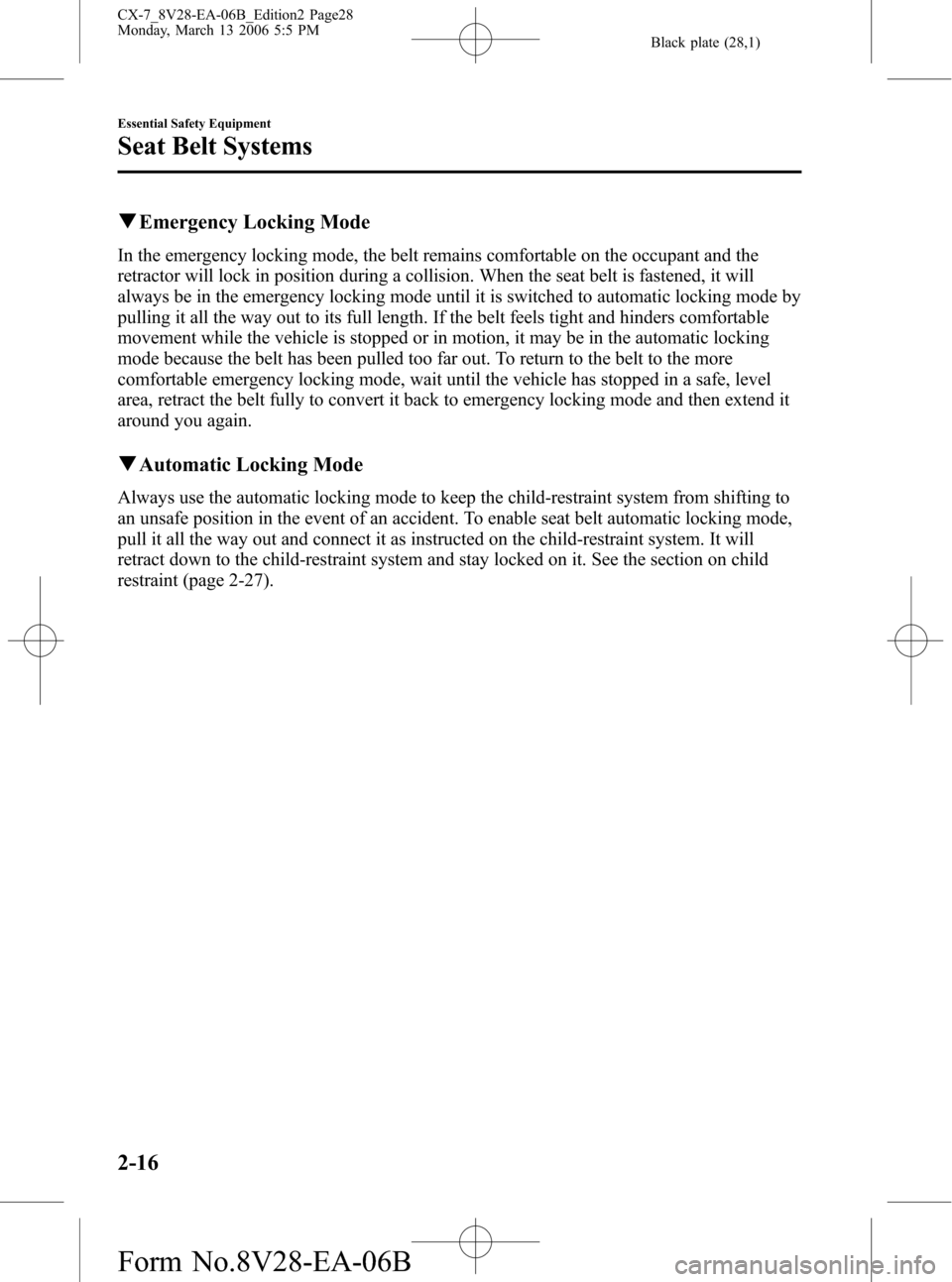
Black plate (28,1)
qEmergency Locking Mode
In the emergency locking mode, the belt remains comfortable on the occupant and the
retractor will lock in position during a collision. When the seat belt is fastened, it will
always be in the emergency locking mode until it is switched to automatic locking mode by
pulling it all the way out to its full length. If the belt feels tight and hinders comfortable
movement while the vehicle is stopped or in motion, it may be in the automatic locking
mode because the belt has been pulled too far out. To return to the belt to the more
comfortable emergency locking mode, wait until the vehicle has stopped in a safe, level
area, retract the belt fully to convert it back to emergency locking mode and then extend it
around you again.
qAutomatic Locking Mode
Always use the automatic locking mode to keep the child-restraint system from shifting to
an unsafe position in the event of an accident. To enable seat belt automatic locking mode,
pull it all the way out and connect it as instructed on the child-restraint system. It will
retract down to the child-restraint system and stay locked on it. See the section on child
restraint (page 2-27).
2-16
Essential Safety Equipment
Seat Belt Systems
CX-7_8V28-EA-06B_Edition2 Page28
Monday, March 13 2006 5:5 PM
Form No.8V28-EA-06B
Page 29 of 406
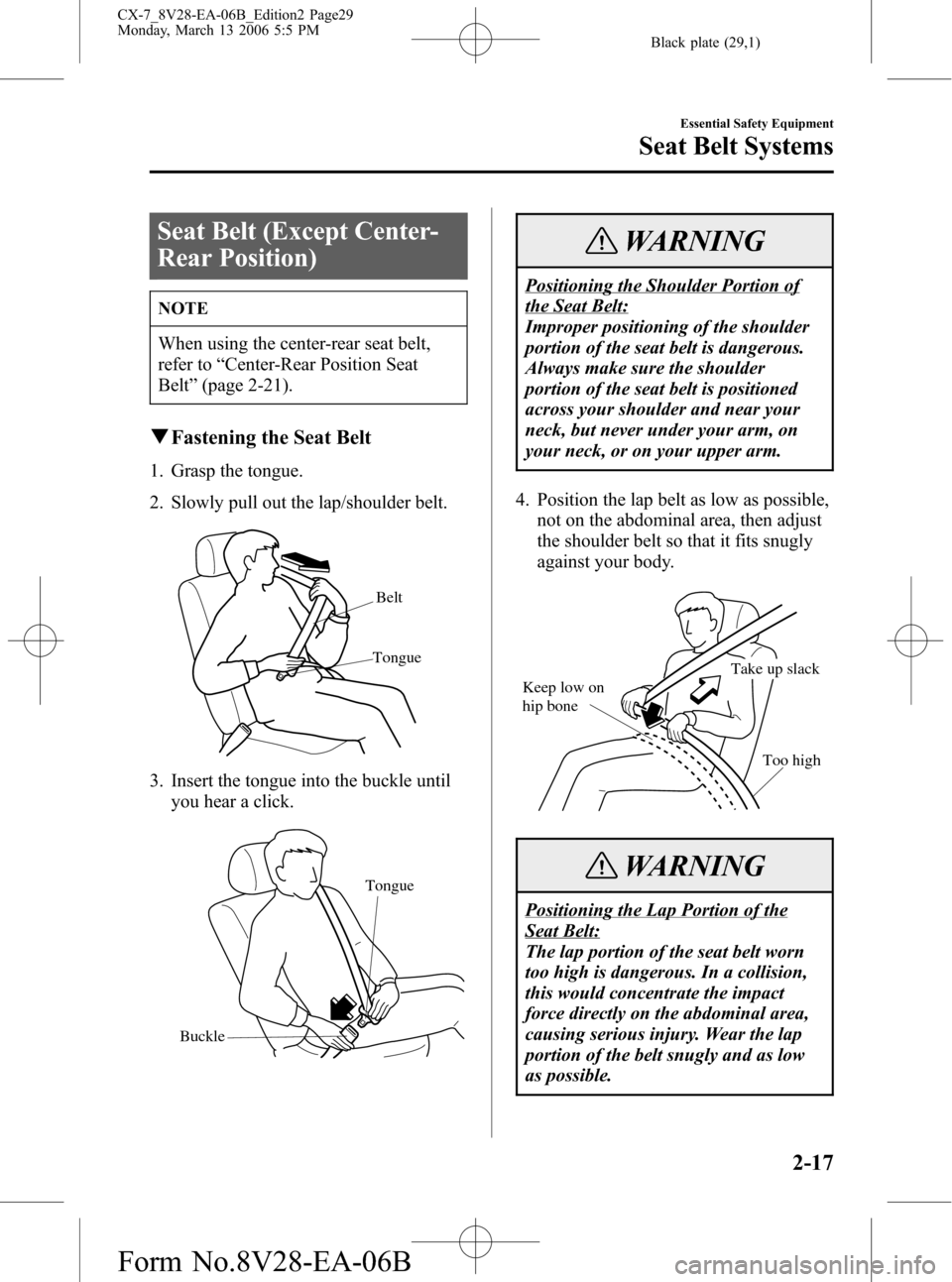
Black plate (29,1)
Seat Belt (Except Center-
Rear Position)
NOTE
When using the center-rear seat belt,
refer to“Center-Rear Position Seat
Belt”(page 2-21).
qFastening the Seat Belt
1. Grasp the tongue.
2. Slowly pull out the lap/shoulder belt.
TongueBelt
3. Insert the tongue into the buckle until
you hear a click.
BuckleTongue
WARNING
Positioning the Shoulder Portion of
the Seat Belt:
Improper positioning of the shoulder
portion of the seat belt is dangerous.
Always make sure the shoulder
portion of the seat belt is positioned
across your shoulder and near your
neck, but never under your arm, on
your neck, or on your upper arm.
4. Position the lap belt as low as possible,
not on the abdominal area, then adjust
the shoulder belt so that it fits snugly
against your body.
Keep low on
hip bone
Too high Take up slack
WARNING
Positioning the Lap Portion of the
Seat Belt:
The lap portion of the seat belt worn
too high is dangerous. In a collision,
this would concentrate the impact
force directly on the abdominal area,
causing serious injury. Wear the lap
portion of the belt snugly and as low
as possible.
Essential Safety Equipment
Seat Belt Systems
2-17
CX-7_8V28-EA-06B_Edition2 Page29
Monday, March 13 2006 5:5 PM
Form No.8V28-EA-06B
Page 30 of 406
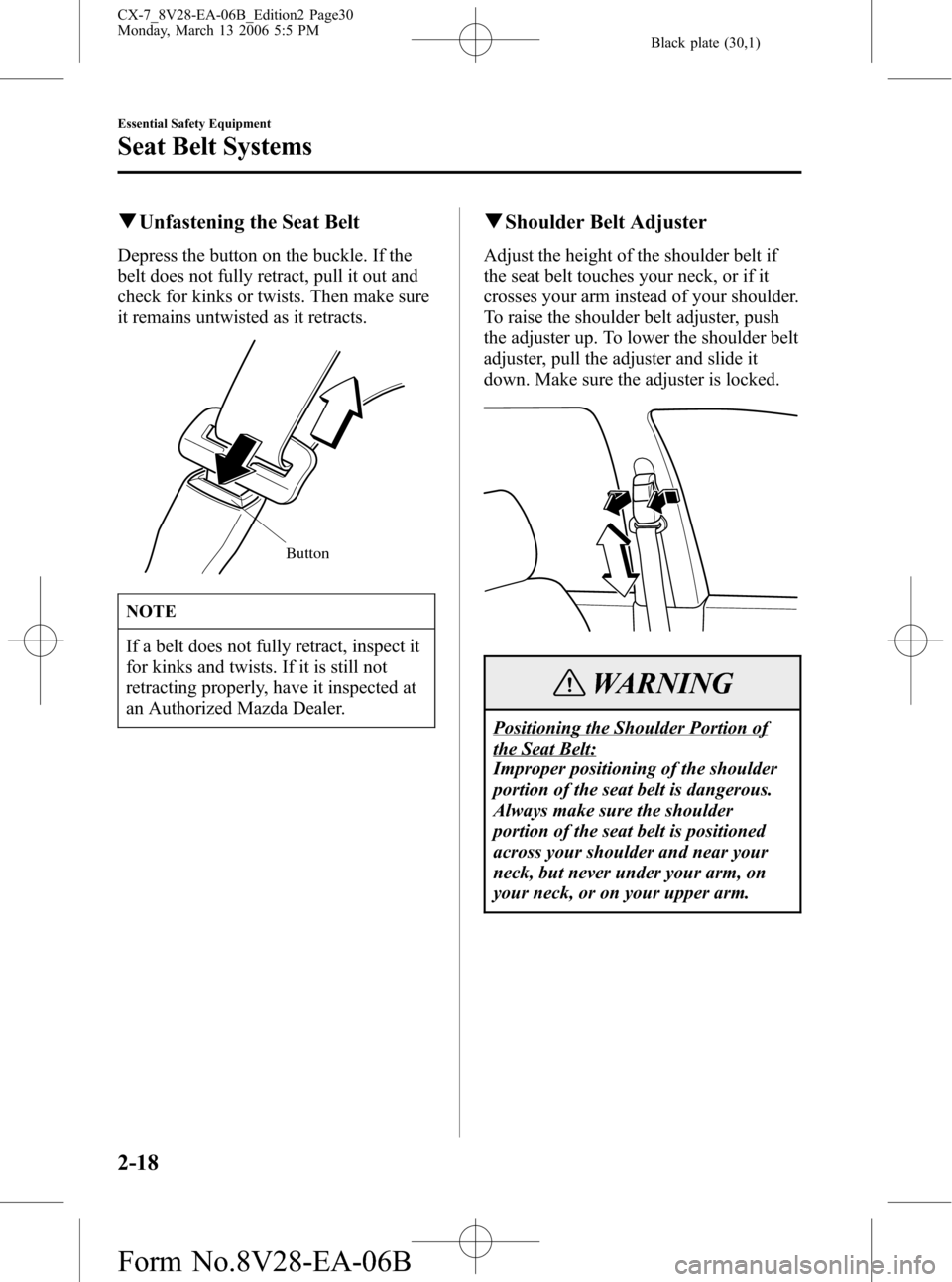
Black plate (30,1)
qUnfastening the Seat Belt
Depress the button on the buckle. If the
belt does not fully retract, pull it out and
check for kinks or twists. Then make sure
it remains untwisted as it retracts.
Button
NOTE
If a belt does not fully retract, inspect it
for kinks and twists. If it is still not
retracting properly, have it inspected at
an Authorized Mazda Dealer.
qShoulder Belt Adjuster
Adjust the height of the shoulder belt if
the seat belt touches your neck, or if it
crosses your arm instead of your shoulder.
To raise the shoulder belt adjuster, push
the adjuster up. To lower the shoulder belt
adjuster, pull the adjuster and slide it
down. Make sure the adjuster is locked.
WARNING
Positioning the Shoulder Portion of
the Seat Belt:
Improper positioning of the shoulder
portion of the seat belt is dangerous.
Always make sure the shoulder
portion of the seat belt is positioned
across your shoulder and near your
neck, but never under your arm, on
your neck, or on your upper arm.
2-18
Essential Safety Equipment
Seat Belt Systems
CX-7_8V28-EA-06B_Edition2 Page30
Monday, March 13 2006 5:5 PM
Form No.8V28-EA-06B